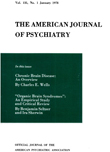ELECTRIC SLEEP-PRODUCING DEVICES: AN EVALUATION USING EEG MONITORING
Abstract
When tested on normal subjects and patients with various psychiatric disorders, the electric "sleep-inducing" devices have been found to be ineffective from a practical standpoint, although behavioral observations and EEG monitoring have indicated the onset of normal drowsiness and sleep patterns in some subjects and patients. No clinically evident EEGdisturbances of a pattern attributed to injury have resulted from the use of the devices. There is some question whether currents of the magnitude employed would penetrate the cranium in sufficient intensity to produce the complex changes theorized in the Russian literature.
Access content
To read the fulltext, please use one of the options below to sign in or purchase access.- Personal login
- Institutional Login
- Sign in via OpenAthens
- Register for access
-
Please login/register if you wish to pair your device and check access availability.
Not a subscriber?
PsychiatryOnline subscription options offer access to the DSM-5 library, books, journals, CME, and patient resources. This all-in-one virtual library provides psychiatrists and mental health professionals with key resources for diagnosis, treatment, research, and professional development.
Need more help? PsychiatryOnline Customer Service may be reached by emailing [email protected] or by calling 800-368-5777 (in the U.S.) or 703-907-7322 (outside the U.S.).



